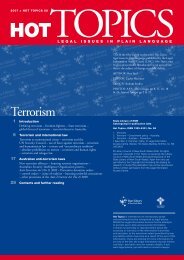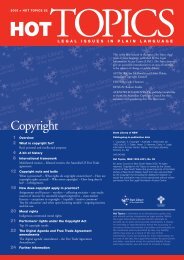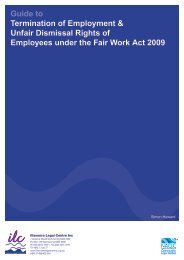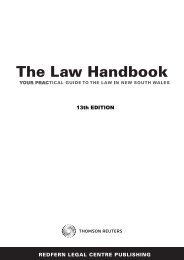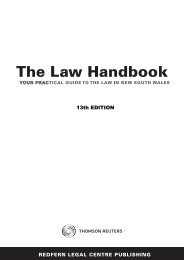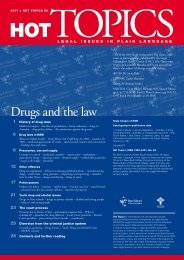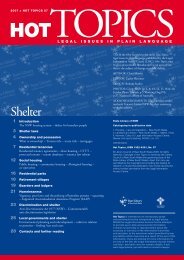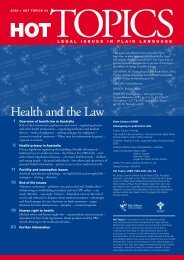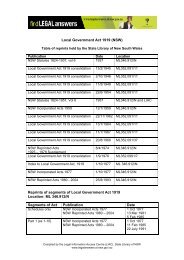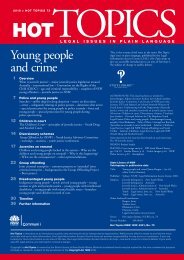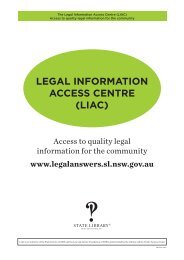Prisoners - Legal Information Access Centre - NSW Government
Prisoners - Legal Information Access Centre - NSW Government
Prisoners - Legal Information Access Centre - NSW Government
You also want an ePaper? Increase the reach of your titles
YUMPU automatically turns print PDFs into web optimized ePapers that Google loves.
those inmates who would be at risk if not separated<br />
from other inmates;<br />
> those inmates who are forensic patients within the<br />
meaning of the Mental Health Act 2007 (<strong>NSW</strong>);<br />
> those inmates who are detained under a preventative<br />
detention order within the meaning of Part 2A of the<br />
Terrorism (Police Powers) Act 2002 (<strong>NSW</strong>);<br />
> inmates who are imprisoned due to a fine default.<br />
Where inmates are required to share a cell, the other<br />
inmate must be carefully selected, and each inmate must<br />
be supplied with a separate bed and bedding. Inmates<br />
who have (or are suspected to have) an infectious<br />
condition may be kept separate from other inmates. An<br />
inmate must not enter a cell that has not been allocated<br />
for their use unless they are authorised by the general<br />
manager or correctional officer.<br />
Inmates can be kept in segregated custody if it is<br />
considered that their association with other inmates is<br />
a threat to:<br />
> the personal safety of any other person;<br />
> the security of a correctional centre;<br />
> good order and discipline.<br />
protective custody<br />
An inmate can be held in protective custody if the<br />
association of the inmate with other inmates constitutes<br />
or is likely to constitute a threat to the personal safety<br />
of the inmate. An inmate can also be held in protective<br />
custody on written request to the Commissioner.<br />
Decisions on segregation and protective custody are<br />
reviewed within a period of 21 days and every three<br />
months after the first review.<br />
seArcHes<br />
An inmate may be searched by a correctional officer<br />
(including strip-searched) as the general manager directs<br />
or as the correctional officer considers appropriate. An<br />
inmate must not be strip-searched by or in the presence<br />
of a person of the opposite sex except in the case of an<br />
emergency. Searching of an inmate must be carried out<br />
with ‘due regard to dignity and self-respect and in as<br />
seemly a manner as is consistent with the conduct of an<br />
effective search’.<br />
It is a correctional centre offence for an inmate to resist<br />
or impede the conduct of a search.<br />
persOnAl prOperTy<br />
All property must be searched when first received and<br />
before it is issued and/or stored. Any property that<br />
is a risk to security or safety will be confiscated. An<br />
Inmate Property Record will be generated at the time of<br />
reception.<br />
The amount of personal property that may be kept <br />
by an inmate depends on the length of their sentence. <br />
Unconvicted inmates and inmates serving sentences <br />
of less than six months are allowed one container <br />
each, and those serving longer sentences are allowed <br />
two containers. All approved property must be able to <br />
be stored in the containers with the exception of the <br />
following additional items:<br />
> electric kettle;<br />
> portable radio;<br />
> television;<br />
> legal papers;<br />
> art/craft item (up to 1 metre square).<br />
Excess property may be confiscated and disposed of <br />
as for property surrendered on reception. Property<br />
cannot be delivered from one inmate to another without <br />
permission. Any food or other property considered<br />
unhygienic can be destroyed. Property in the cell must <br />
be kept tidy (so that searches are not impeded).<br />
clothing<br />
Inmates receive a standard issue of clothing (3 t-shirts; <br />
fleecy tracksuit top/sloppy joe; fleecy tracksuit pants; 2 <br />
pairs of shorts; 4 singlets; 5 pairs of underpants; 5 pairs <br />
of socks; 1 pair of shoes).<br />
There is a list of additional clothing items that can be <br />
provided to inmates depending on their needs and the <br />
location of the correctional centre.<br />
Private clothing may be delivered to a correctional <br />
centre for:<br />
> court appearances;<br />
> approved short-term leave;<br />
> external education or employment programs; and<br />
> prior to discharge or deportation.<br />
discipline And punisHmenT<br />
Inmates must comply with the correctional centre’s<br />
routine and hours of work. They must obey any call<br />
to muster in a particular area when asked by an officer<br />
or notified by bell, whistle or siren etc. Inmates must<br />
submit to breath testing for alcohol or provide a urine<br />
sample for drug testing if it is suspected that they are<br />
under the influence of alcohol or drugs.<br />
Any contravention of the provisions in the Crimes<br />
(Administration of Sentences) Act is a ‘correctional centre<br />
offence’. There are also a number of correctional centre<br />
offences created under the Crimes (Administration of<br />
Sentencing) Regulation 2008. They are set out in clauses<br />
124- 146 and Schedule 2 of the regulations. The range of<br />
sanctions that may be imposed by the general manager<br />
of the correctional centre includes:<br />
> reprimand and caution;<br />
imprisonment in nsW 25



